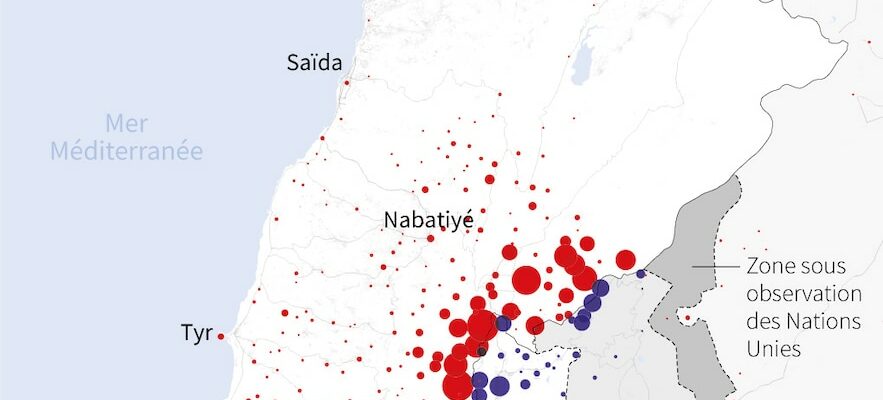Tensions between the Lebanese Hezbollah and Israel have been increasing in intensity for several days. Since Monday, September 23, intense Israeli strikes have targeted the strongholds of the pro-Iranian Shiite movement in southern and eastern Lebanon as well as in the southern suburbs of Beirut. They have left hundreds dead, while the number of displaced Lebanese is approaching half a million, Lebanese Foreign Minister Abdallah Bou Habib said on Tuesday, September 24.
The attacks came after several major blows to Hezbollah last week: deadly explosions hit the movement’s communications equipment, while an Israeli strike killed 55 people, decapitating its elite force, al-Radwan, including leader Ibrahim Aqil. Hezbollah responded by firing toward northern Israel: the Islamist movement announced on Wednesday, September 25, that it had targeted the headquarters of Mossad, Israel’s foreign intelligence service, near Tel Aviv with a ballistic missile. The Israeli army said it had intercepted the projectile.
The targets
The Israeli army said on Wednesday morning that it was carrying out “large-scale” strikes in southern Lebanon and the Bekaa region (east).” It said in a statement that it had struck Hezbollah targets and weapons storage facilities. On the night of Tuesday to Wednesday, Israeli fighter jets carried out a series of strikes on Hezbollah targets on Lebanese territory, the Israeli army also said. It said it had “struck terrorists operating within Hezbollah’s terrorist infrastructure, weapons storage facilities, launchers and other terrorist targets,” according to the statement.
Map of southern Lebanon and northern Israel showing the number of airstrikes or artillery strikes by Israeli military forces and Hezbollah by location between October 7, 2023 and September 20, 2024.
© / Valentina BRESCHI, Paz PIZARRO, Valentin RAKOVSKY, Nalini LEPETIT-CHELLA / AFP
The day before, the Israeli army had already announced new strikes targeting the infrastructure and weapons of the Islamist movement. “In the last few hours, the army struck Hezbollah terrorist targets in southern Lebanon, including rocket launchers, terrorist infrastructure sites and buildings in which weapons were stored,” it said in a statement.
An Israeli strike also targeted a mountain village north of Beirut for the first time on Wednesday morning, the official National News Agency (ANI) and residents reported. Residents of the Shiite village of Maaysara, located in the mountainous region of Kesrouan, which is predominantly Christian, confirmed to AFP that they had heard two loud explosions in their locality located about thirty kilometers from the capital of Lebanon. “We will continue to strike Hezbollah. And I say to the Lebanese people: our war is not against you” but “against Hezbollah,” declared Benjamin Netanyahu in a video released by his office.
Hezbollah Commanders Killed
Hezbollah confirmed on Wednesday that one of its military leaders, Ibrahim Mohammed Kobeissi, had been killed in an Israeli bombardment on Tuesday on the southern suburbs of the capital. “Mohammed Kobeissi was an important source of knowledge in the field of missiles and maintained close ties with senior military leaders of Hezbollah,” according to the Israeli army. “At least two” other commanders of Ibrahim Kobeissi’s force were also “eliminated,” Israeli military spokesman Rear Admiral Daniel Hagari said at a press briefing.
Ibrahim Kobeissi joined the Lebanese Shiite movement in the 1980s and held several military positions, including that of head of the Badr unit, in charge of one of Hezbollah’s three zones of operations in southern Lebanon, according to the Israeli army.
Last week, deadly explosions hit the movement’s communications equipment, and an Israeli strike on Beirut’s southern suburbs on September 20 dealt a new blow to Hezbollah, killing 16 fighters from its elite unit, including Ibrahim Aqil.
The objectives pursued by Israel
According to Kobi Michael, an analyst at the Misgav Institute for National Security and Zionist Strategy, interviewed by AFP, the Israeli military objectives would be to drive Hezbollah fighters from the area between the Litani River in Lebanon and the Israeli-Lebanese border some thirty kilometers away, and to prevent their return.
Israeli authorities have said the strikes are aimed at securing northern Israel and allowing families in those areas to return home. Between 60,000 and 90,000 Israeli citizens have fled the north of their country in the past year or so, fearing war with Lebanon. “We will use all necessary means to restore security on our northern border, so that our citizens can return home safely,” Netanyahu said last week during a visit to the north. On Sunday, September 22, the Israeli prime minister said his country could not “tolerate shooting at its people” and reiterated his determination to act for the return of those evacuated from the north.
But that return requires peace in northern Israel, which is highly unlikely in the short term, as Calev Ben-Dor, a former analyst at the Israeli Foreign Ministry, told AFP. “The initial logic, shared by Israel and the Biden administration, was that a ceasefire in Gaza would lead to tranquility in the north,” he said. However, over time, “the chances of a ceasefire in Gaza are diminishing,” at a time when “most of Israel’s military objectives in Gaza have been achieved,” which would give Israel room to reallocate its units.
